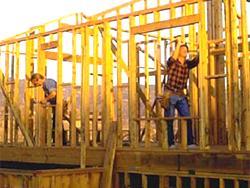NAHB Study Optimistic About Future Demand
Washington, DC, Nov. 18, 2010 -- Annual single-family housing production in 2008 and 2009 fell about one million units short of the housing that would be needed in a normally functioning economy, according to a study by economists at the National Association of Home Builders.
The report suggests that builders will have a lot of catching up to do as the economy improves and household formations return to trend levels.
The report, "Extent of Underbuilding in the Single-Family Housing Market," finds that there was an excessive amount of single-family building from 2003 through 2005, but overbuilding largely ended by 2006 and the subsequent downturn was severe enough to more than offset those annual surpluses.
This year is likely to add to the growing deficit of single-family homes by another one million units, the report finds.
"The single-family housing market in the U.S. currently finds itself in a significantly underbuilt state," said NAHB Chairman Bob Jones.
"Pent-up demand for housing will at some point need to be worked off, pushing single-family production in a positive direction. In the meantime, the deficit continues to grow as builders remain cut off from the credit they need to begin developing and building new housing."
The analysis compares levels of single-family permits in recent years with the long-term trend that would be seen if housing, labor and credit markets were functioning normally and generating a normal rate of household formations.
Single-family permits plunged to a trough of 441,000 in 2009, their lowest level since World War II.
The previous post-war low occurred in 1981, when 550,000 single-family permits were recorded.
Adding to the magnitude of the recent downturn, multifamily starts and permits last year fell below 150,000 units, an historic low, compared to about 400,000 units annually during the early 1980s.
The report says that single-family permits should have hit 1.4 million by 2005, 1.5 million by 2008 and around 1.56 million in 2009. Instead, permits were well over 1.4 million in 2003 and pushed past 1.6 million in both 2004 and 2005, "a period of serious overbuilding."
Subsequently, however, permits dropped to under 1.4 million by 2006 — already slightly below trend — and continued to fall through last year.
